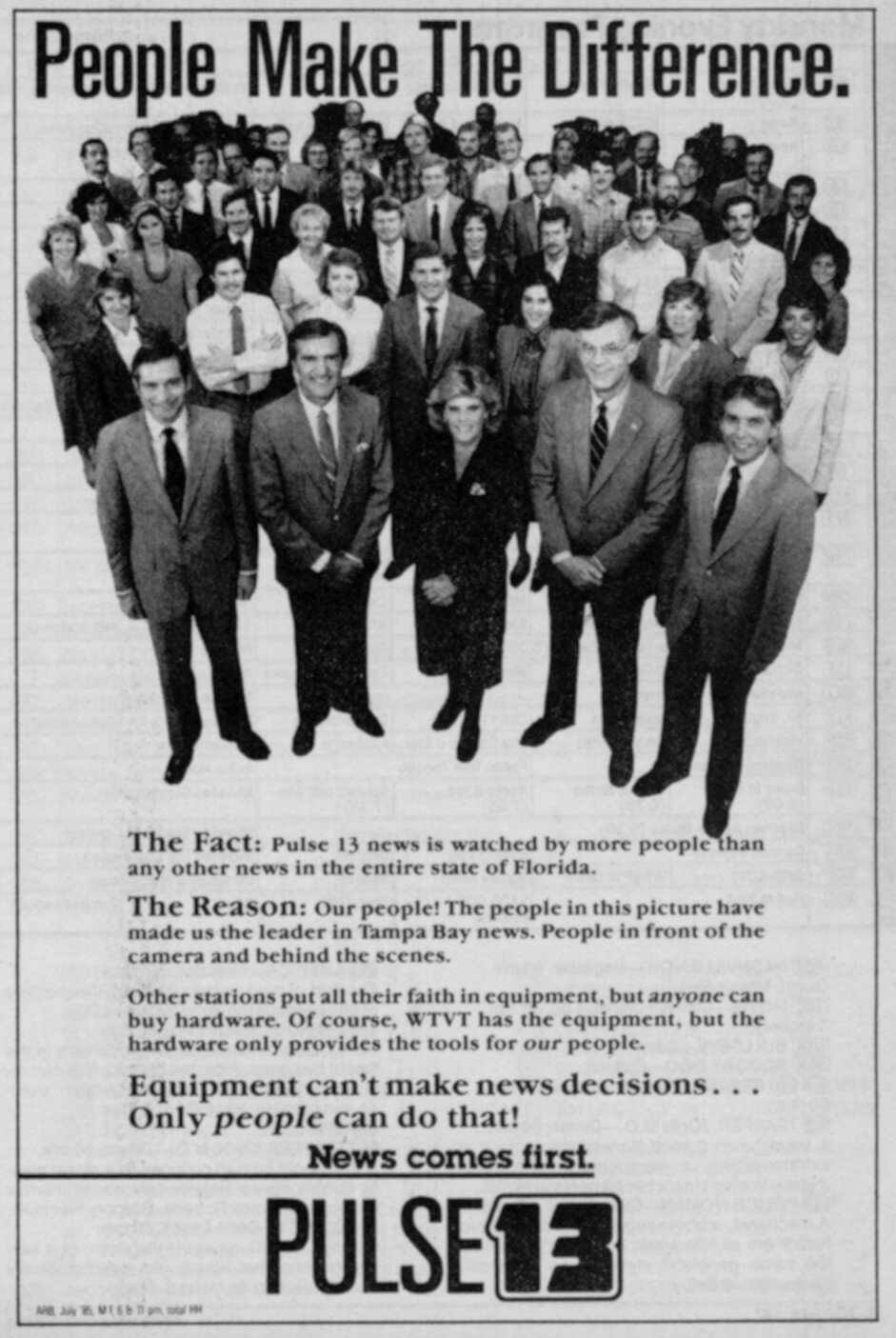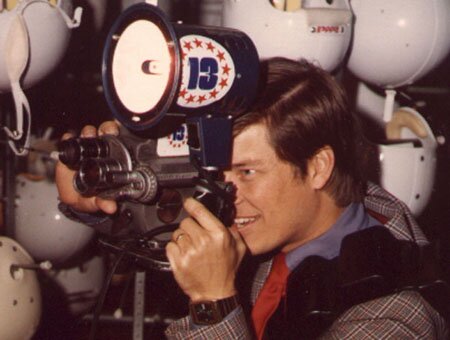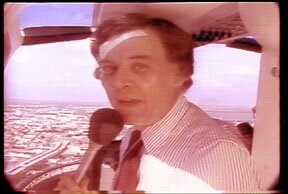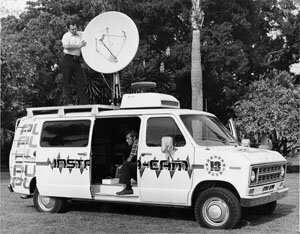N.E.W.S. GOES E.N.G.
Soon to be obsolete...no, not Pete Johnson...the camera!
This Bell and Howell 16mm windup camera was replaced by
ENG and portable video tape camera equipment.
(PHOTOGRAPHY BY LINDA ROSSI/PHOTO COURTESY PETE JOHNSON/)
The news department was always ready to take advantage of improvements in television technology. In 1975, they experimented with an early video tape camera package. The camera, a consumer-sized color unit with a separate 1/4" video recorder, proved too delicate for day to day operations.
By the late 70's, field reports were being produced and edited
on 3/4" U-Matic video tape
By 1976, professional ENG equipment became more practical. The cameras were similar in size to the 16mm ones used since day one, but the recording unit was a separate, bulky 3/4" U-Matic unit. Still, tape offered instant playback and did not require processing. The changeover meant news could be aired quicker, but it also meant the demise of the huge film lab behind the studio. Such is progress! Eventually, the camera and recorder were combined into one unit that weighed a hefty 25 pounds, but it made the cameraman totally portable and able to cover a fast moving story.
WTVT became the first station in the market to take the portable video equipment and link it with new, smaller microwave units.
To announce the arrival of ENG (Electronic News Gathering) on May 17, 1976, Hugh Smith appeared live at the beginning of Pulse from a helicopter hovering 500 feet over downtown Tampa. </>It was the latest triumph for WTVT news, following a tradition of innovation and professional reporting. Channel 13 soon modified small cargo vans to become ENG trucks, roving the Tampa Bay area and supplying live feeds back to the station. Jule McGee, Duane Martin, and Bill Napier of the engineering department supervised the construction of the first ENG vehicles. One of the first 'live' ENG stories were covered by Terry Casey and Duane Martin, involving a potential night time flood situation in Pinellas County.
E.N.G. News Van...version 1.0. Engineer Bill Napier adjusts microwave unit on top while Harvey Jurin checks readings inside
Technology continued to provide new opportunities in news coverage. WTVT invested in a satellite news truck, and became a prime user of the CONUS satellite network. Live reports from Tallahassee and other parts of the state became a regular feature on Pulse News.

In 1985, Hugh Smith gained a co-anchor in Kelly Craig...the first female co-anchor for the 6 p.m. PULSE newscast. Another Kelly (Ring) also joined the program and continues to co-anchor to this day.
In 1989, long-time anchor Smith was almost replaced on air until a vocal public let their feelings be known. Smith was paired as a co-anchor with Frank Robertson and left the station two years later.
For almost 25 years, Pulse News was number one in the ratings. The tabloid reporting style of the 1980's and 1990's made the traditional model of a newscast obsolete, and maintaining a ratings lead for 13's news is not the slam-dunk it used to be in 60's and 70's.
In the late 1980's, News Director Bob Franklin surmised that "Pulse" was no longer the best moniker for Channel 13's news program. "Eyewitness News" was commonly used as the title for news blocks at stations across the country, and WTVT followed suit. Sharyl Attkisson anchored the last Pulse newscast at 6pm on a Sunday night. "Eyewitness News" started at the 11pm block with Roy Leep, Andy Hardy, Frank Robertson and Kelly Craig appearing on a rare Sunday night. (In an odd coincidence, Attkisson also anchored on the last ever CBS Evening News on 13.. also on a Sunday night. WTVT switched to Fox at Midnight that night).
WTVT has many reasons to be proud of its tradition as the news leader in the Tampa Bay market. BIG 13 is proud to tell its wonderful story.
NEWS LINKS ON THE 'BIG 13' SITE
Wayne Fariss, who signed Channel 13 on the air, is profiled in Wayne Fariss, First With The News
Dick John was news director and anchor from 1956 to 1958, and tells the story of how Gaylord Broadcasting expanded the news department and set the tone for 50 years of excellence. To learn more about the early days of Channel 13 news, see Newsroom, 1956 by Dick John.
The first Tallahassee bureau chief, John Evans, describes the early days of state capitol reporting in "John Evans, Covering the State Capital."
In A Conversation with Crawford Rice. The former news director (1958-60) and general manager (1977-81) of WTVT, Rice shares many personal memories and observations of Pulse and other station-related topics.
Learn about news from the 60's to the 90's in Hugh Smith: A View From the Anchor Desk.
Find out the inside story of Ray Blush and Project 13 in "Ray Blush...Project 13 and Beyond."
He produced some of the most memorable stories about the Tampa Bay area and the state of Florida. Read all about his career in "Larry Elliston, Channel 13's 'Down Home' Feature Man"
One of the higher profile Channel 13 alumni, John Ferrugia recalls his time at WTVT in "John Ferrugia...On The Road With Project 13"
He was the anchor of Pulse Plus! and considered to be one of the station's most talented on-air people. Read about him in "The Amazing Journey of Scott Shuster."
Pulse Extra was the creation of producer/director Bob Gilbert. His story is called "Bob Gilbert: A Guy With Something Extra"
To Return to NEWS MENU CLICK HERE
CLICK HERE FOR SPORTS
For some personal memories of some of the above people, click here.


